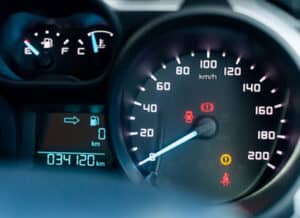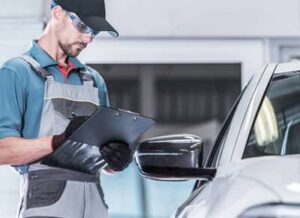With the increase in fraudulent activity on cars and their documents, you may be forced to wonder if a VIN is fake or not. Some car sellers go as far as carrying out odometer fraud, providing fake titles, and even using fake VINs. According to the NHTSA, 450,000 vehicles are sold each year with false odometer readings. In this article, we will learn about VINs and what each character on a VIN represents, then discover how to spot a fake VIN number.
What is a VIN number?
A Vehicle Identification Number (VIN) or VIN number is a 17-character code that is placed on every vehicle by the manufacturer. This code is unique to each vehicle produced and is usually a mix of numbers and letters. With this VIN, a vehicle history report can be generated containing every piece of recorded information on that vehicle. The information generated will contain auction and sales history, accident and damage records, theft records, service and maintenance records, odometer readings, lien records, salvage, junk, and rebuilt records, and other details.
A VIN number usually has 17 characters, but on some occasions, you may observe that some vehicles have VIN numbers that are less than the standard 17 characters. This is not a cause for alarm as they are not fake VIN numbers. The standard was introduced in 1980, and classic vehicles and antiques do not have up to 17 characters. This is because the number of characters a VIN had was determined by the manufacturer until 1980.
READ ALSO: How to get a Vehicle’s original window sticker by VIN
Parts of a VIN number
There is more to a vehicle identification number than just a string of numbers. It can be divided into parts, each of which stands for a different piece of knowledge about the vehicle. Having knowledge of these parts would help you discover vehicles with fake VINs. These parts give the following information at a glance:
Vehicle specifications, such as the model, body style, engine, and trim level. This is donated by the next five digits.
The year of the vehicle’s manufacture is encoded in the tenth character.
Is it easy to fake a VIN number?
Yes, it is easy to fake a VIN number. It’s not as difficult as one might think. A fraudster only needs to take their time and make the VIN correct enough to fool a buyer. Then they produce new VIN plates with the fictitious VIN and install them on the parts of the vehicle where VINs are usually found.
The only problem with doing this is that fake VINs are easily identified by government agencies and companies offering vehicle history reports at affordable prices, such as Instant VIN Reports, Detailed Vehicle History, Premium Vin, Vehicles Report, and others.
Since 2009, it has been more difficult, but still possible, to “double-register” someone who has stolen or copied a VIN. This is due to the fact that states are currently connecting their registrations to the NMVTIS, or National Motor Vehicle Title Information System. But, if this is true, how do we detect fake VIN numbers and catch fraudsters? We will find out in the next section.
How to spot a fake VIN number
When a vehicle identification number has been altered or faked, there are some tips that will help you notice. These tips are:
#1 Get a Vehicle History Report
This is the best and easiest way to prove the authenticity of a Vehicle Identification Number (VIN). A vehicle history report is a document that shows the history of a vehicle. It provides information such as accident and damage records, theft records, insurance history, salvage records, hail damage records, ownership history, auction records, loan and lien information, odometer verification, fire damage history, and others. With this information obtained from a vehicle history report, you can verify the car’s specifications and also determine if the vehicle is carrying a fake VIN number.
To get a vehicle history report, all you need to do is:
- Get the VIN number of the vehicle.
- Visit Instant VIN Reports and enter your VIN number.
- Decode your VIN and get your vehicle history report.
You can now confirm if the vehicle has a fake VIN number or not.
#2 Carry out a proper inspection.
The vehicle’s VIN number can be found in several places, and you should begin by checking for the VIN in all these places:
- Dashboard, right under the windshield.
- Driver’s side door, just by the doorpost.
- Front of the engine block.
By carrying out a proper inspection and taking note of the VIN number in the different spots, you may be able to detect if the VIN is fake or not. How? Here’s how. In some cases, you will observe that there are irregularities in the VIN; you might find a different VIN on the front of the engine block and another on the dashboard. When you begin to see such irregularities, you can now conclude that the VIN number is fake. Also, observe if the plates and labels are clear and do not look tampered with.
READ ALSO: How to lookup Florida custom license plate
#3 Check the vehicle registration documents.
Vehicle registration documents such as the certificate of title and bill of sale usually contain information about the vehicle and carry the VIN number. In addition to these documents, the window sticker often provides valuable details about the vehicle’s original features and specifications, including the VIN. You can confirm the authenticity of the VIN by comparing the number on the window sticker with the one on the vehicle. If they match, it’s likely that the VIN is authentic. If they don’t, the VIN may be fraudulent.
#4: Perform a License Plate Lookup
A license lookup will not only confirm the authenticity of the VIN but also provide you with records that prove the reliability of a vehicle. With a license plate lookup, you can also generate a vehicle history report and be sure of accident records, damage records, theft history, and every other piece of information about the vehicle.
Overall, the best way to determine the authenticity of a vehicle’s VIN is by generating a vehicle history report. When purchasing a used vehicle from a seller, be certain and cautious of your source. If you have any doubts, don’t forget to follow the tips and steps explained above to verify the VIN number and determine if it’s a fake VIN number or not.










